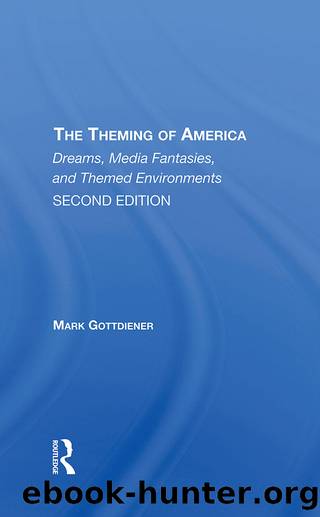The Theming Of America, Second Edition by Mark Gottdiener

Author:Mark Gottdiener [Gottdiener, Mark]
Language: eng
Format: epub
Tags: Business & Economics, Free Enterprise & Capitalism, Social Science, General, Sociology
ISBN: 9781000306286
Google: JynJDwAAQBAJ
Publisher: Routledge
Published: 2020-01-08T03:50:07+00:00
Las Vegas Casinos
Almost a quarter century ago, three architectsâRobert Venturi, Denise S. Brown, and Steven Izenourâpublished a spectacularly prescient book, Learning from Las Vegas (1972). In their exhaustive study of the Vegas architecture of that time, they identified a new design phenomenon, namely the rejection of modernist architecture that ignores symbols in favor of building that emphasizes signs and symbols of all kinds. According to the authors (and as I have discussed in Chapter 2), modernist architecture actively avoided the use of symbols and instead emphasized austere, blank walls of glass and steel, and simple, abstract geometric shapes like the tall rectangles of the flat-roofed skyscrapers built in central cities for decades. As Venturi and his associates observed during their visits in the late 1960s and early 1970s to Las Vegas, architecture there represented a thorough rejection of modernism. It was built, in fact, as if modernist doctrines had never existed.
The Las Vegas casino environment is a multidimensional system of signs. Both the built forms and the messages conveyed are highly developed and articulated as intentional symbols. Signs are everywhere. They direct traffic off the main interstate highway to the streets on which the various hotel/casinos can be found. They advertise individual casinos and their attractions, such as food and headliner entertainment. The signs also amuse through computer-generated electronic light displays. What caught the eyes of Venturi and his associates in the 1960s is this amazing contrast between the rather austere, businesslike environment of the large city, with its one overarching theme of modernism (that is, of "being modern"), and the explosion of light, sound, and symbols in the garish milieu of Las Vegas casino facades. What was true three decades ago is even more so today, as one new casino/resort after another tries to outdo the competition in the extent of its theming.
The function of the Las Vegas themed environment is straightforward: to seduce the consumer. Las Vegas is a multidimensional experience of seducing pleasuresâmoney, sex, food, gambling, nightlife. Las Vegas constitutes a specialized space. It is one of several global "pleasure zones," like Monte Carlo and the French Riviera (Monte Carlo and Riviera are also the names of Las Vegas casinos), the Greek islands, Rio de Janeiro (the name of another Las Vegas casino), Disneyworld, Marienbad, and the Taj Mahal. According to Venturi and associates, "Essential to the imagery of pleasure-zone architecture are lightness, the quality of being an oasis in a hostile context, heightened symbolism, and the ability to engulf the visitor in a new role: vacation from everyday reality" (1972: 53).
At one time this themed excess was meant to capture potential gamblers passing by on the old highway from California, now Interstate 15. But today's neon and fantasy facades are less oriented toward automobile traffic and more designed as tools in the competition for a larger share of the more than $5.7 billion total annual revenue from tourism. In this sense, casino theming fights the competition located elsewhere, including other pleasure zone destinations around the world, as well as within the Las Vegas metro region itself.
Download
This site does not store any files on its server. We only index and link to content provided by other sites. Please contact the content providers to delete copyright contents if any and email us, we'll remove relevant links or contents immediately.
International Integration of the Brazilian Economy by Elias C. Grivoyannis(92243)
The Radium Girls by Kate Moore(11935)
Turbulence by E. J. Noyes(7944)
Nudge - Improving Decisions about Health, Wealth, and Happiness by Thaler Sunstein(7622)
The Black Swan by Nassim Nicholas Taleb(7016)
Rich Dad Poor Dad by Robert T. Kiyosaki(6414)
Pioneering Portfolio Management by David F. Swensen(6231)
Man-made Catastrophes and Risk Information Concealment by Dmitry Chernov & Didier Sornette(5926)
Zero to One by Peter Thiel(5694)
Secrecy World by Jake Bernstein(4653)
Millionaire: The Philanderer, Gambler, and Duelist Who Invented Modern Finance by Janet Gleeson(4386)
The Age of Surveillance Capitalism by Shoshana Zuboff(4216)
Skin in the Game by Nassim Nicholas Taleb(4166)
Bullshit Jobs by David Graeber(4104)
The Money Culture by Michael Lewis(4083)
Skin in the Game: Hidden Asymmetries in Daily Life by Nassim Nicholas Taleb(3935)
The Dhandho Investor by Mohnish Pabrai(3706)
The Wisdom of Finance by Mihir Desai(3659)
Blockchain Basics by Daniel Drescher(3511)
